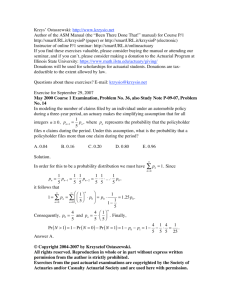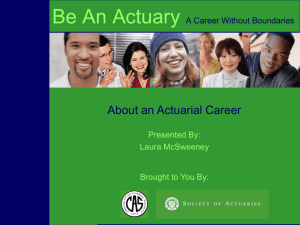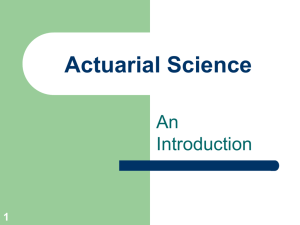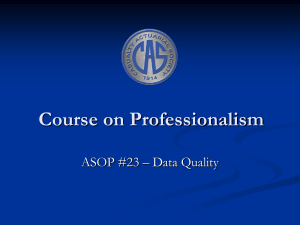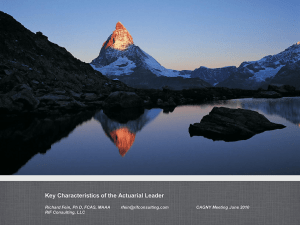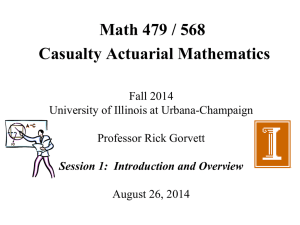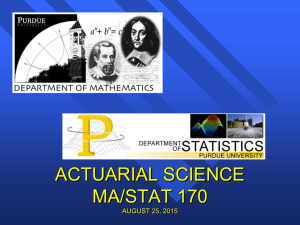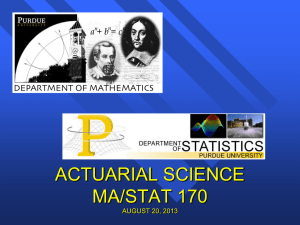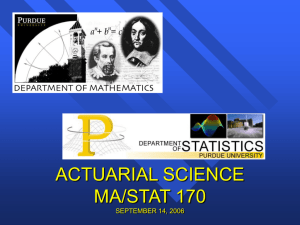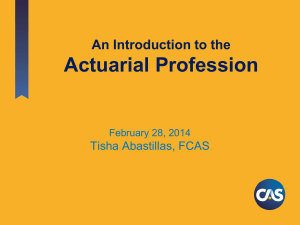Actuarial Career Presentation - Ramapo College of New Jersey
advertisement
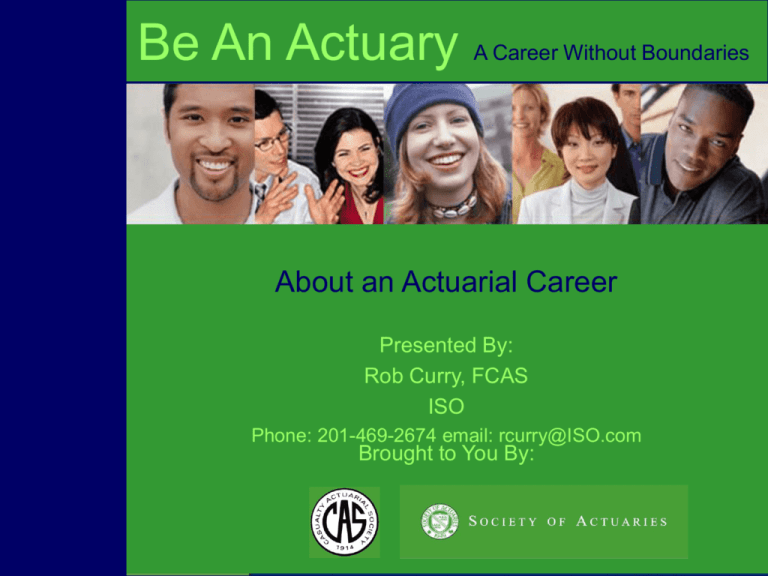
Be An Actuary A Career Without Boundaries About an Actuarial Career Presented By: Brought to You By: Rob Curry, FCAS ISO Phone: 201-469-2674 email: rcurry@ISO.com Brought to You By: Overview My Background What is an Actuary? Where do Actuaries work? What do Actuaries do? Why become an Actuary? What is the career outlook? What skills and talents are needed? How can you become an Actuary? Background Rutgers Grad BS Math How did I find out about the profession Fellow of CAS ISO Property/Casualty Not an insurance company Provide data and analytics to insurance industry www.iso.com What is an Actuary? An Actuary is a person who: Analyzes, manages and measures the financial implications of future risk. Develops and validates financial models to guide decision making. Typically an actuary uses data from the past to predict the future Driving a car by looking in the rear view mirror Need to quantify how the future will be different from the past Impact of large increases in price of gas on auto insurance costs Most Common Industries Where Actuaries Work Insurance Industry Property (home) and casualty (auto) 4,000 actuaries Life and annuities 18,000 actuaries Employee Benefit Industry Retirement benefits Health benefits Social Security Financial Services Industry Banks, investing, risk management Mergers & Acquisitions Typical Actuarial Projects Life Insurance: Designing and pricing life insurance products Property & Casualty: Estimating the cost of personal auto or homeowners insurance in a particular area. Impact of AIDS on mortality tables Global Warming Impact Health Benefits: Setting HMO premium rates. Retirement Systems: Pricing the cost of increasing retirement benefits Interesting Actuarial Problems Property/Casualty Actuary Automobile Insurance and Credit Scores Catastrophe Insurance Coverage – wildfires, hurricanes, earthquakes, etc. How to account for population shifts or rare events Example of an Actuarial Problem IPOD Insurance What are some factors that you would consider for deciding what to charge for IPOD insurance Same Price for everyone? Why not? Does location matter? What do you think you are getting by buying IPOD insurance? Why Become an Actuary? Use your math expertise to solve real world problems High earning potential No cost of graduate school – “learn while you earn” Typically given paid time off to study for exams Advance by examinations – no “glass ceiling” Skills are highly transferable to other industries and job responsibilities Newsworthy projects High demand – less sensitive to economic cycles Job security; need expected to grow Overall, a highly ranked profession Jobs Rated Almanac Actuary was rated the #2 job in America, according to the 2002 Jobs Rated Almanac. #1 Biologist - #2 ACTUARY #3 Financial Planner #4 Computer Systems Analyst #5 Accountant #6 Software Engineer #7 Meteorologist #8 Paralegal Assistant #9 Statistician #10 Astronomer Jobs Rated Almanac (cont.) Actuary has been rated as one of the top five jobs in each of the six editions published since 1988. Actuary has received the #1 job rating twice! Ranking is based on 6 factors: Income, Outlook, Stress, Environment, Physical Demands and Security Salary Information Starting salaries of $41,000 - $52,000 (with one exam and no experience) Merit increases Examination increases E.g. $2,500 per exam at ISO Increases for professional designations Source: D.W. Simpson & Company, Inc., 2006 Salary Survey Earning Potential Average Actuarial Salaries $250,000 $200,000 1 Exam 4 Exams 7 Exams Fellow $150,000 $100,000 $50,000 $0 0.0 - 4.5 4.6 - 9.5 9.6 - 14.5 14.6 + Years of Experience Note: Compensation may vary significantly according to years of experience, geographic region and responsibilities. Source: D.W. Simpson & Company, Inc., 2006 Salary Survey Career Outlook for Actuaries Employment growth for consulting actuaries Development of new financial tools Growing ability to model risks Data Mining/GLM/Neural Nets Growth in the health services industry Growth in risk management Disadvantages of the Career Difficulty of the examination process Only about 40% pass ratio for each exam Huge time commitment, 200+ hours per exam Length of time to complete exams 7-9 years Some people never do )-: Frustrating, yet challenging problems Narrow field with high degree of specialization Consolidation of Insurance Companies May need to work several years on routine projects before you get the “sexy” ones What Skills are Needed to be an Actuary? Knowledge of math and finance Computer skills Keen analytical, project management and problem solving skills Solid communication skills (oral & written) Good business sense Ability to see and/or argue both sides of an issue. How to Become an Actuary Like a doctor or lawyer, an actuary achieves professional status by passing examinations to prove a certain level of knowledge. Actuarial examinations are administered by the Casualty Actuarial Society (CAS) and Society of Actuaries (SOA). Three of the first four exams are administered jointly. Examinations are held twice a year (1/P – four times/year) Two professional designations exist for each organization: Associate (either ASA or ACAS) Fellow (either FSA or FCAS) You can earn while you learn - employers support actuarial trainees taking exams by providing exam study time on the job. Preliminary Education Structure Prerequisites Calculus Linear Algebra Validation by Educational Experience (VEE) VEE credits are obtained through college courses (B- or higher), standardized exams and approved educational experiences for: VEE- Applied Statistical Methods VEE- Corporate Finance VEE- Economics http://www.soa.org/education/educationredesign/edu-validation-by-educationalexperience.aspx Preliminary Education Structure Preliminary Examinations Joint Exam 1/P: Probability A. General Probability B. Univariate Probability Distributions: binomial, negative binomial, geometric, uniform, hypergeometric,Poisson, exponential, Pareto, normal, chi-square, beta, lognormal, gamma, and Weibull C. Multivariate Probability Distributions Joint Exam 2/FM: Financial Mathematics A. Interest Theory B. Finance CAS Exams In addition to the preliminary education, each society has additional requirements to achieve professional designations CAS total of 9 Exams (1-7 for Associateship) 3 – Statistics and Actuarial Models Soon to be two separate exams (one part joint with SOA) 4 Construction & Evaluation of Actuarial Models (Joint with SOA) 5 – Intro to Property & Casualty Ratemaking 6 – Reserving, Accounting, Reinsurance 7 – Regulation, Taxation, Annual Statement 8 – Investments and Financial Analysis 9 – Advanced Ratemaking, Rate of Return Advice for Students Who Want to be Actuaries Develop disciplined study habits. Acquire a well-rounded curriculum, including classes approved for VEE credit. Sharpen your communication and general business skills. Take actuarial exams while in school - the sooner you start, the sooner you will finish. Find an actuarial internship. Familiarize yourself with Insurance Issues Advancing Diversity Minority Students: African American, Latino, or Native American Scholarships for Minority Students Individual awards of $500 - $3,000, annually Demonstrated performance and commitment Exam Fee Reimbursement for Minority Students Reimbursed for successfully passing Exam P/1 and/or FM/2 Visit the website www.BeAnActuary.org Minority Programs: Scholarship applications, exam fee reimbursement forms, internships, and more. Actuarial Jokes Wanted to be an Accountant but… How do you know that you are talking to an outgoing Actuary… How many actuaries does it take to change a light bulb… Questions and Answers To learn more about the actuarial profession, exams, and internships, visit BeAnActuary.org Casualty Actuarial Society - www.casact.org Society of Actuaries - www.soa.org
